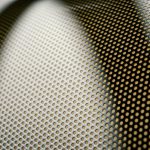You’ll find Nomex Mylar fabric composites combine heat-resistant Nomex with tough, moisture-resistant Mylar, making them lightweight yet durable. They handle extreme heat, resist tearing, and provide excellent electrical insulation, perfect for aerospace, automotive, and industrial uses. To keep them in top shape, handle with clean gloves and store away from sunlight. As new technologies emerge, these composites are set to become even stronger and more versatile. Explore how these innovations could impact your applications.
Table of Contents
Key Takeaways
- Nomex Mylar fabric composites combine heat-resistant Nomex with durable, moisture-resistant Mylar for enhanced thermal and mechanical performance.
- These composites offer exceptional flame resistance, tensile strength, chemical stability, and lightweight properties for harsh environment applications.
- Common uses include aerospace insulation, electrical protection, automotive thermal barriers, and industrial fire-resistant clothing.
- Proper handling involves using clean gloves, storing in cool dry places, gentle cleaning, and avoiding creases to maintain integrity.
- Innovations include nanotechnology, graphene integration, bio-based resins, and additive manufacturing for improved durability and eco-friendliness.
Composition and Properties of Nomex Mylar Fabric Composites
Nomex Mylar fabric composites combine the heat-resistant strength of Nomex with the durability and flexibility of Mylar film.
When you work with this composite, you get a material that resists high temperatures and mechanical stress without sacrificing flexibility.
Nomex, a meta-aramid fiber, provides excellent thermal stability and flame resistance, while Mylar, a polyester film, adds tensile strength and moisture resistance.
Nomex delivers thermal stability and flame resistance, while Mylar enhances tensile strength and moisture protection.
The composite’s layered structure guarantees you benefit from both components—Nomex’s fibrous texture supports heat protection, and Mylar’s smooth film enhances durability and barrier properties.
You’ll find these composites lightweight yet tough, making them ideal for applications requiring a balance of strength, heat resistance, and flexibility.
Understanding the composition helps you appreciate why this material performs so well under demanding conditions.
Advantages of Using Nomex Mylar in Harsh Environments
When you face extreme temperatures and mechanical stress, choosing a material that stands up to these challenges is crucial.
Nomex Mylar offers exceptional thermal resistance, protecting you from heat and flame without degrading. Its outstanding mechanical strength means it resists tearing and abrasion, so your equipment stays intact under tough conditions.
The composite’s chemical stability guarantees it won’t break down when exposed to solvents or moisture, giving you long-lasting durability.
Plus, Nomex Mylar’s lightweight nature doesn’t add unnecessary bulk, making it easier to handle and install.
With excellent electrical insulation properties, it keeps your systems safe from short circuits even in demanding environments.
Using Nomex Mylar means you’re investing in reliability and protection when it matters most.
Typical Applications Across Industries
Although you mightn’t see it every day, Nomex Mylar fabric composites play an essential role in many industries.
Nomex Mylar fabric composites quietly support essential functions across diverse industries every day.
When you work with aerospace components, you’ll appreciate their lightweight strength and heat resistance, making them perfect for insulating wiring and protecting sensitive equipment.
In electrical applications, these composites help you prevent short circuits and improve safety by providing excellent dielectric properties.
If you’re in the automotive field, you’ll find Nomex Mylar useful for thermal barriers and sound insulation.
Even in industrial settings, you can rely on them for protective clothing and fire-resistant barriers.
Handling and Maintenance Best Practices
Since these fabric composites are often used in critical applications, you’ll want to handle them with care to maintain their protective qualities.
Always wear clean gloves when touching Nomex Mylar composites to avoid oils and dirt transferring from your hands. Store them in a cool, dry place away from direct sunlight to prevent degradation.
When cleaning, use a soft brush or a damp cloth with mild detergent—never harsh chemicals or abrasive tools. Inspect the material regularly for signs of wear, tears, or delamination, and address any damage promptly to avoid compromising performance.
Avoid folding or creasing the fabric unnecessarily, as this can weaken the structure. By following these simple steps, you’ll extend the lifespan and effectiveness of your Nomex Mylar fabric composites.
Innovations and Future Trends in Composite Materials
Proper care and maintenance keep Nomex Mylar fabric composites performing at their best, but advancements in composite technology are reshaping what’s possible.
You’ll soon see smarter, lighter, and stronger materials emerging, driven by nanotechnology and improved resin systems. Innovations like graphene integration enhance durability and electrical conductivity, while bio-based resins offer eco-friendly alternatives without compromising performance.
You can expect composites with better thermal resistance and self-healing properties, reducing downtime and extending product life.
Additive manufacturing also lets you customize composite structures with precision, cutting waste and improving efficiency.
Staying updated on these trends helps you choose materials that meet evolving demands, ensuring your projects benefit from the latest breakthroughs in strength, flexibility, and sustainability.
Frequently Asked Questions
How Does Nomex Mylar Compare Cost-Wise to Other Composite Materials?
You’d think Nomex Mylar’s price tag screams “budget-friendly,” but nope—it’s kind of the luxury sedan of composites. You’ll pay more than for plain fiberglass, but it’s worth the flair and fire resistance you get.
Can Nomex Mylar Fabric Composites Be Recycled or Reused?
You can recycle or reuse Nomex Mylar fabric composites, but it’s tricky. They’re durable and resistant, so you’ll likely need specialized processes or repurpose them creatively instead of traditional recycling methods to minimize waste.
What Is the Environmental Impact of Producing Nomex Mylar Composites?
Like Prometheus stealing fire, producing Nomex Mylar composites demands energy and raw materials, impacting the environment. You’ll find emissions, resource use, and waste, so balancing benefits with sustainability is vital in your choices.
Are There Any Health Risks When Working With Nomex Mylar Fabric?
You might experience irritation from dust or fibers when handling Nomex Mylar fabric. Always wear protective gear like gloves and masks to minimize risks, and work in a well-ventilated area to stay safe and comfortable.
How Long Does Nomex Mylar Fabric Composite Typically Last in Outdoor Use?
You can expect Nomex Mylar fabric composites to last several years outdoors, typically around 5 to 10 years. However, exposure to harsh sunlight, moisture, and abrasion can shorten their lifespan, so regular care helps.
- Acoustic Scrim Fabric: How to Improve Sound Quality in Any Space - June 26, 2025
- The Role of Carbon Laid Scrims in High-Performance Composites - June 26, 2025
- What Is Scrim Fabric Used For? 10 Surprising Applications - June 26, 2025







